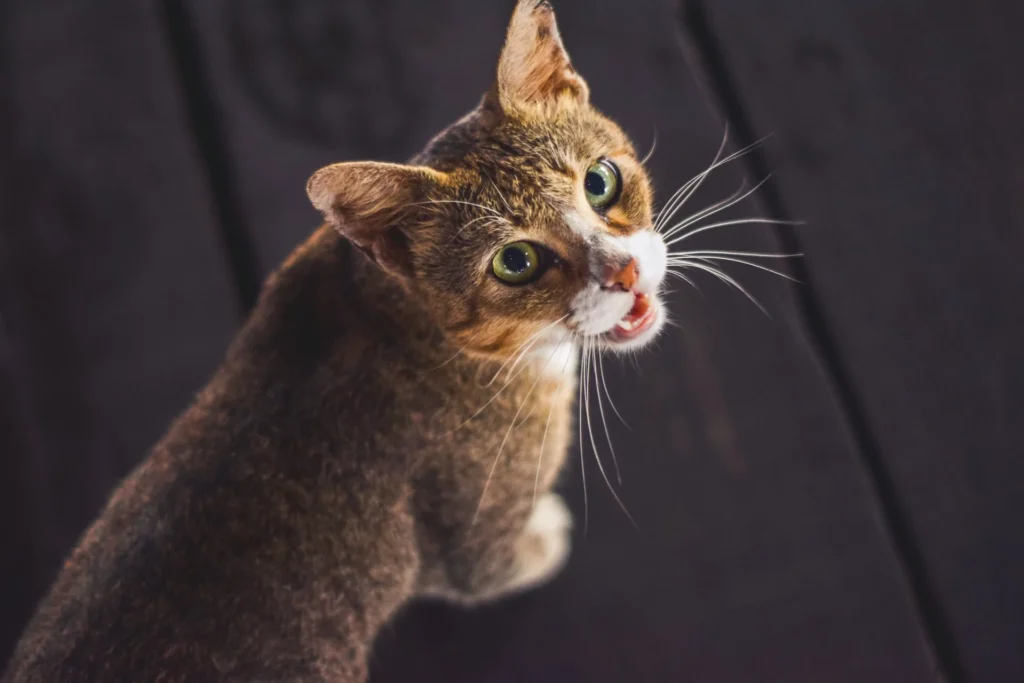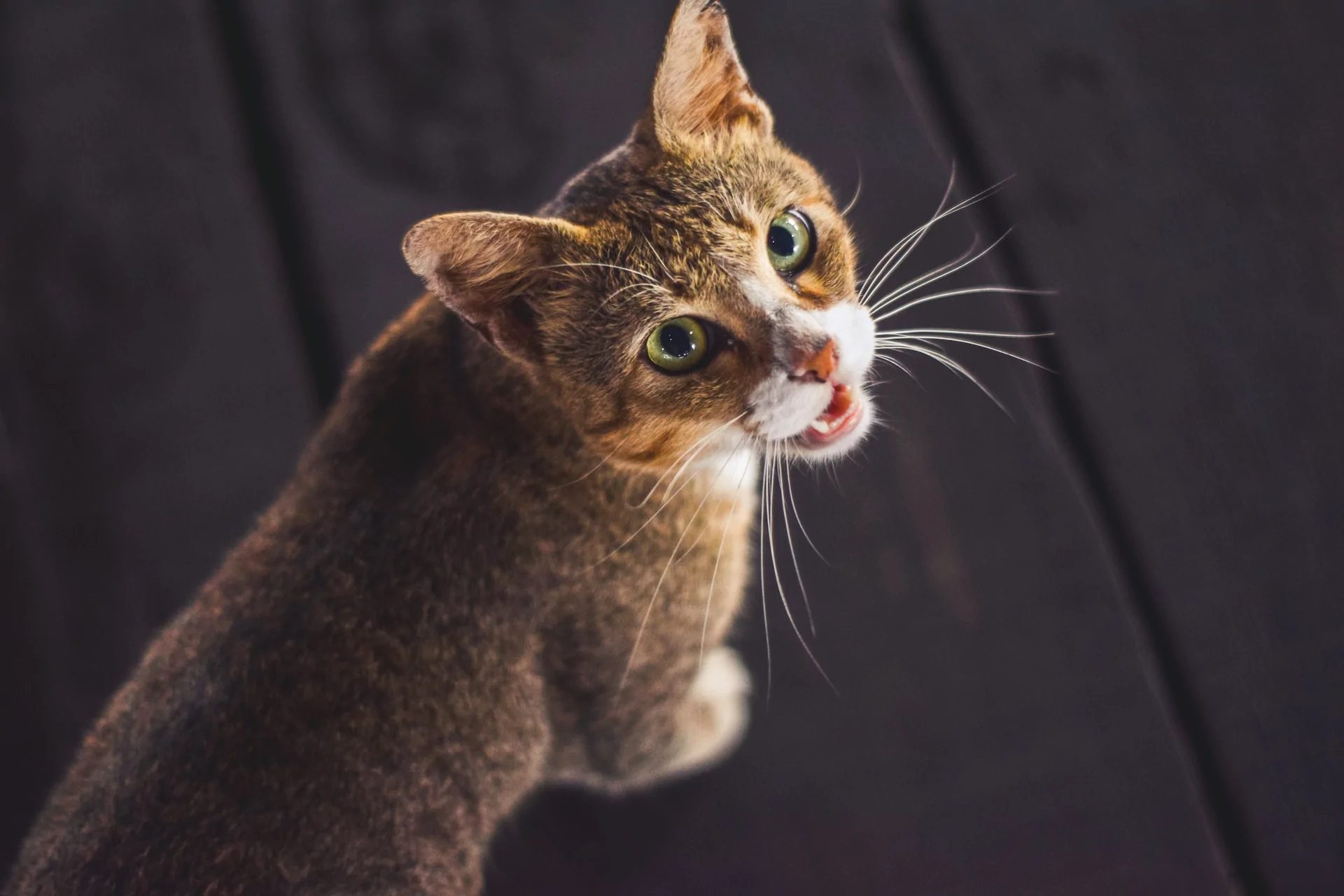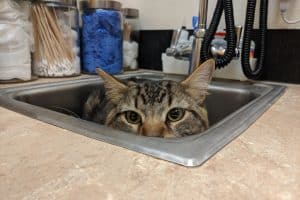Note: We may earn a commission from helpful, relevant links in our content. No cost to you. See our privacy policy.
Cats, just like us, can feel the weight of stress, and as their loving caretakers, it’s our responsibility to recognize the signs and lend a paw to help.
Not only can stress make your feline friend’s life miserable, but it can also lead to long-term health issues. So, it’s crucial to spot the symptoms early to keep your cat purring with happiness.
In this article, we’ll dive into the telltale signs of stress in cats and explore some practical ways to restore their tranquility.

Signs Your Cat May Be Stressed
The most common signs your cat may be stressed include:
- Changes in Appetite. Pay attention to shifts in your cat’s eating habits. A stressed cat might eat significantly more or less than usual, leading to potential weight changes.
- Hiding and Isolation. Cats are known for their love of solitude, but excessive hiding or isolation could indicate that your feline friend is feeling stressed and anxious.
- Aggression. A stressed cat may become more aggressive or irritable, engaging in hissing, growling, biting, or swatting even when unprovoked.
- Excessive Grooming. Stressed cats may develop an OCD-like habit of excessive grooming, sometimes to the point of causing bald patches or skin irritation. This behavior might be hidden from their owners but can be an indicator of stress.
- Repetitive Behaviors. A stressed cat may also display repetitive behaviors, such as pacing, circling, or constant scratching, as a coping mechanism to deal with anxiety or stress.
Recognizing the signs of stress in your cat is crucial for ensuring their well-being and happiness. As you become familiar with your feline friend’s unique behaviors, you’ll be better prepared to support them in times of need and foster a more nurturing, stress-free environment.
For reference, and to better understand your cat’s behavior patterns, here are some of the common cat behaviors and how to recognize them.
Common Causes of Stress in Cats
Cats can experience stress for various reasons, and understanding these common triggers can help you create a more comfortable and relaxed environment for your purring pal. Here are some typical causes of stress in cats:
- Changes in the environment. Cats are creatures of habit, and even minor changes in their surroundings, such as rearranging furniture, bringing new objects or people into the home, or moving to a new location, can cause stress.
- Lack of resources. Competing for resources such as food, water, or litter boxes, especially in multi-cat households, can be a significant source of stress. Make sure to provide ample resources for each cat to reduce tension.
- Loud noises. Cats have sensitive hearing, and loud or sudden noises, like construction work or fireworks, can trigger stress.
- Conflict with other animals. Encounters with other cats, dogs, or animals, either inside or outside the home, can be a source of stress for your cat. Monitor interactions to ensure they remain peaceful.
- Medical issues. Illness or pain can cause stress in cats, so it’s essential to keep up with regular vet checkups to address any potential health concerns promptly.
By addressing these stressors, you can provide your feline friend with the comfort and peace they deserve, creating a bond that lasts a lifetime.
How to Alleviate Stress for Your Feline Friend
Environmental Enrichment
The first you should try to do to reduce stress in your cat is to provide a stimulating environment.
Engage their natural instincts by providing toys, scratching posts, and climbing structures.
Interactive playtime is also crucial, so set aside time each day to play with your cat using toys like feather wands or laser pointers.
For example, Smokey, my male cat, loves chasing after this laser pointer, which helps him release pent-up energy and reduces his stress levels. I try not to overdo it, as too much of this game may actually create more stress.
Consistent Routine
Cats are creatures of habit, and maintaining a consistent daily routine can help reduce stress.
This includes regular feeding times, playtime, and grooming sessions. By sticking to a predictable schedule, you’re providing a sense of stability and security for your feline friend.
Safe Spaces
Every cat needs a safe and comfortable space where they can retreat and relax. Provide cozy hiding spots, such as cardboard boxes, cat tunnels, or covered beds.
Make sure these spaces are easily accessible and located away from high-traffic areas or potential stressors like loud noises.
For instance, when I noticed Smokey becoming anxious during a thunderstorm, I created a cozy hideaway for him in a quiet corner of the room. Having this safe space to retreat to helped him feel more secure and less stressed during storms.
By implementing these practical strategies, you can help alleviate stress in your cat’s life, creating a happier and healthier environment for both of you.
Here are a few more insightful tips from Jackson Galaxy:
FAQs
Can I use calming pheromones to reduce stress in my cat?
Calming pheromones, such as Feliway, can help reduce stress in cats by replicating natural feline facial pheromones that promote feelings of security and comfort.
How do I know if my cat’s stress is severe?
If your cat displays extreme changes in behavior, such as prolonged hiding, self-harming, or refusal to eat or drink, it may indicate severe stress, and you should consult a veterinarian.
Can stress cause health problems in my cat?
Prolonged stress in cats can lead to health problems, including a weakened immune system, gastrointestinal issues, and an increased risk of urinary tract infections.
How can I create a stress-free environment for my cat?
To create a stress-free environment for your cat, provide a consistent routine, safe spaces to retreat, environmental enrichment, and ample resources such as food, water, and litter boxes.
Alex, a passionate animal lover, has experience in training and understanding animal behavior. As a proud pet parent to two dogs and three cats, he founded AnimalReport.net to share insights from animal experts and expand his knowledge of the animal kingdom.










